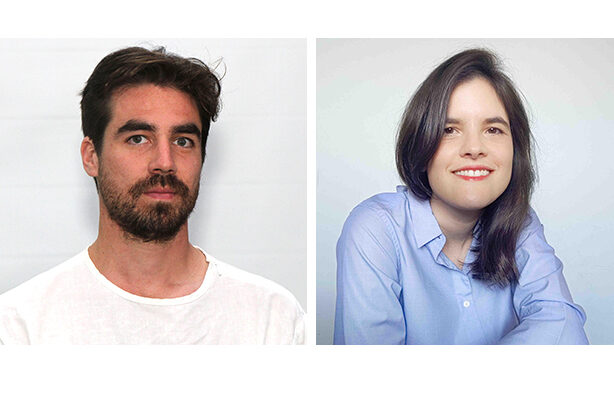News
Jesse McCormick and Mariana Righi Named Inaugural Spitzer Fellows
Jesse McCormick and Mariana Righi have been selected as the inaugural Spitzer Fellows, to be in residence at Spitzer during the 2022-23 academic year. McCormick will work on “Speculative/Unspeculative: Land Banks in New York State,” while Righi’s project is “Construction of a Concrete-Foam Structure Using Recycled EPS Formwork, Computer Vision, and Robotic Fabrication.”
McCormick received a Bachelor of Arts from the State University of New York at Binghamton and a Master of Architecture from Columbia University, where he won the William Kinne Traveling Fellowship and the Lucille Smyser Lowenfish Prize. In addition to design practice, he has contributed to the Oslo Architecture Triennale, the Istanbul Design Biennale, the Storefront for Art and Architecture, and as a research scholar at Columbia University.
Righi received her undergraduate degree in architecture from the School of Architecture, Design and Urbanism at the University of Buenos Aires, Argentina. She holds a Master of Arts in the history and culture of architecture and city from the School of Architecture and Urban Studies, Torcuato di Tella University, Buenos Aires, Argentina, and a Master of Science in advanced architectural design from the Stuart Weitzman School of Design at the University of Pennsylvania. Until recently, Righi was a research and teaching assistant at the Autonomous Manufacturing Lab and Polyhedral Structures Laboratory at the University of Pennsylvania. She has been an adjunct assistant professor at Temple and Northeastern Universities and University of Buenos Aires. Her research interests center on exploring the relationship among materials, technology, aesthetics, and culture.
Speculative/Unspeculative: Land Banks in New York State
Land banks are nonprofit, government-adjacent entities with state-sanctioned powers to bypass legal and financial barriers for the acquisition and redevelopment of vacant or abandoned properties to better serve the public interest, instituted as a last resort in areas suffering from chronic depreciation. In 2009, a provision of the Federal Housing and Recovery Act allocated hundreds of millions of dollars collected in fines from financial institutions found responsible for the 2008 financial collapse to expand land banks’ powers to mitigate the ensuing crisis. While land banks have existed in the United States since the 1970s, 85 percent were chartered after 2010, totaling 250 as of this writing.
Land banks, however, are not explicitly designed to build affordable housing or combat displacement. As organizations determine their structure and mission individually, they often participate in the same real estate processes linked with gentrification: raising property values, unregulated private sales, and neighborhood revitalization with no accountability. In this ambiguity, and relative infancy, however, land banks possess the dual faculties to either reinforce harmful development paradigms or function as a tool for reparative urban strategies.
The goal of McCormick’s research is to articulate the latent potential of the land bank not as a last resort in triage, but as a generative device that can instigate an ideological reframing of the structures that determine the built environment, and to speculate on the role of architecture in the application of more nuanced, robust, and equitable urban and economic practices.
Construction of a Concrete-Foam Structure Using Recycled EPS Formwork, Computer Vision, and Robotic Fabrication
Expanded polystyrene or EPS foam is a common international construction material for structural elements, molds, and insulation. In the past 20 years, the architectural construction industry has benefited from the addition of robotic foam-cutting techniques to produce ruled and double curved surfaces. However, the waste produced during this process is concerning because EPS waste finds its way into landfill sites and is not biodegradable.
The purpose of Righi’s research is using computational methods, robotic fabrication, and computer visualization to rethink a construction system using recycled polystyrene parts. This research aligns with the idea of perceiving design and fabrication as a dynamic computational composition, which contributes to the ways waste materials are disposed of and reused and complex architecture artifacts are designed and constructed.
About the Spitzer Fellowships
The Spitzer School of Architecture’s new fellowship supports up-and-coming designers, practitioners, planners, spatial activists, advocates, historians, and other academics in their research in architecture, landscape architecture, sustainability, or urban design. Applications in all areas of architectural research, design, technology, digital techniques, computation, history, theory, and pedagogy were invited, with the goal of making the Spitzer School a hub of innovation that advances racial and gender justice, supports new and emerging voices, and is welcome to promising practitioners and academics from historically under-represented groups. The principal concern is to advance Fellows’ research projects, although Fellows are also asked to participate in the Spitzer School’s rich culture by joining reviews, giving one public lecture, and in other ways sharing research findings with the Spitzer community. Researchers are encouraged to develop long-term relationships with Spitzer faculty and students, the City College community, and external organizations, stakeholders, and community members, and use them to inform new theories of architectural practice.


